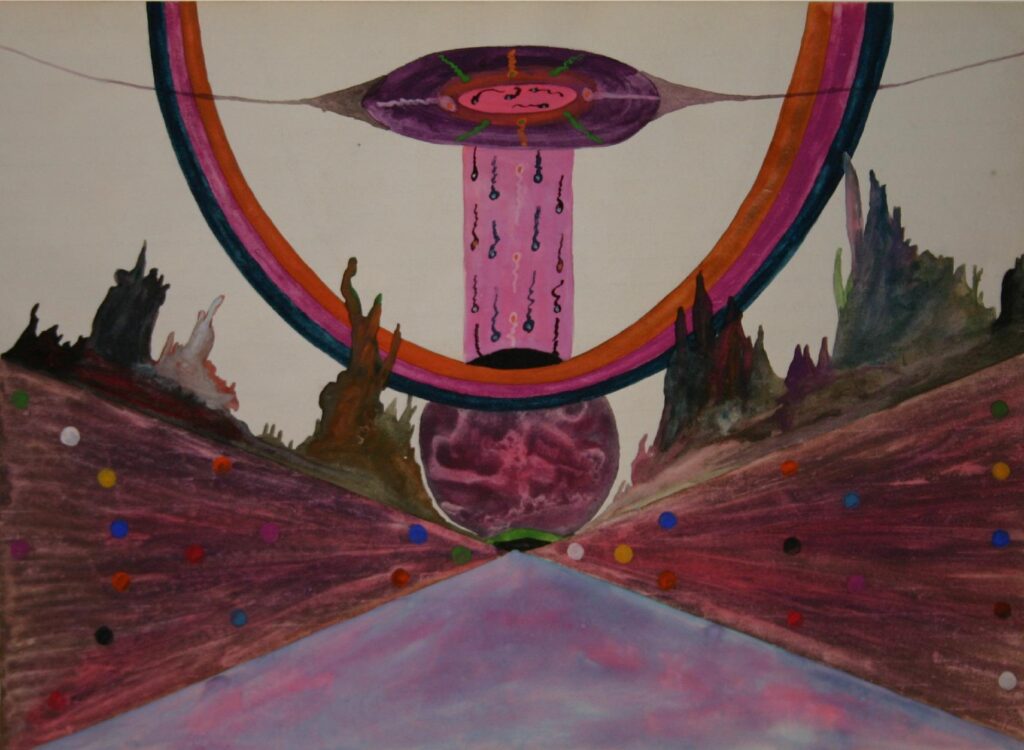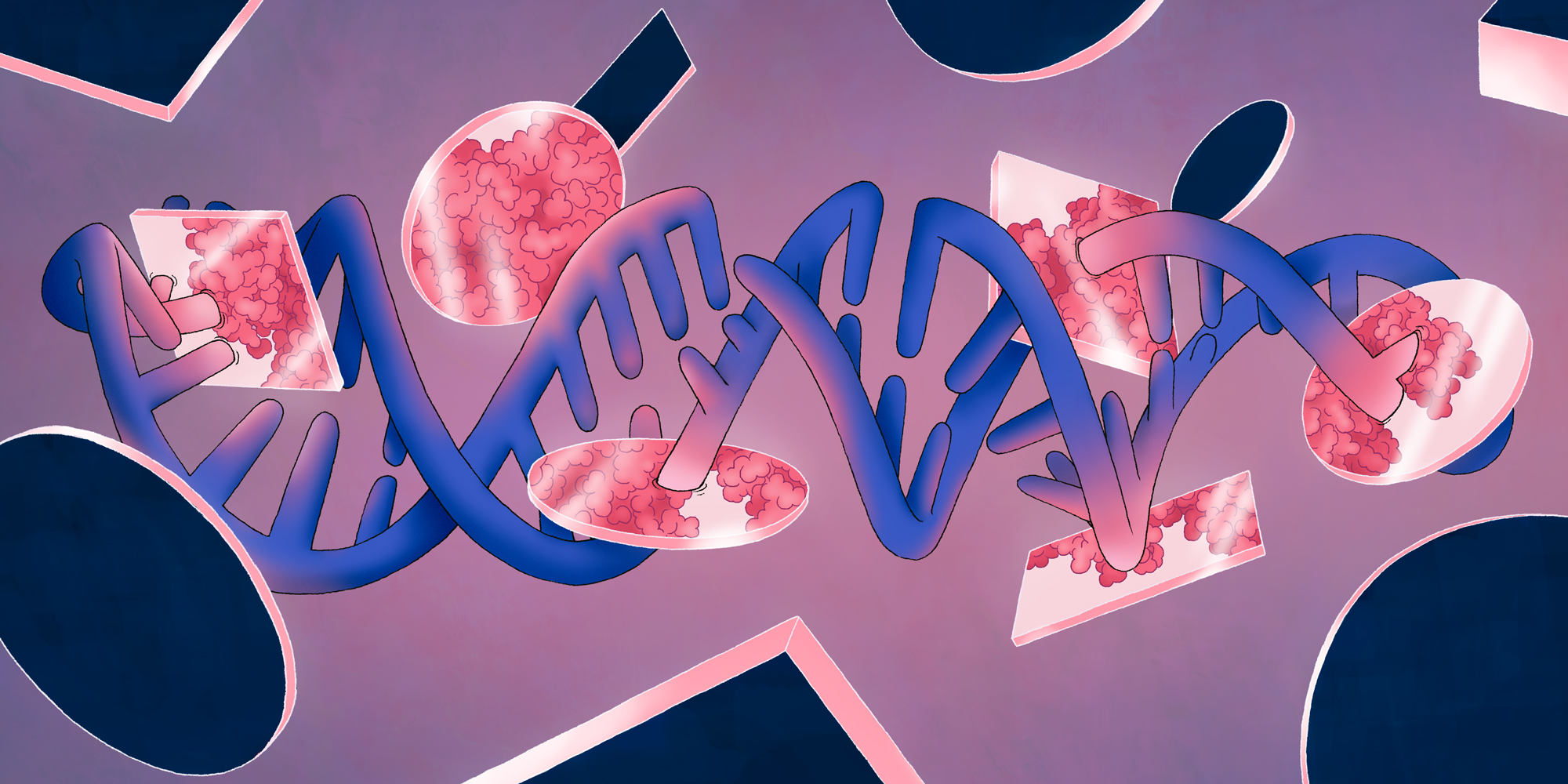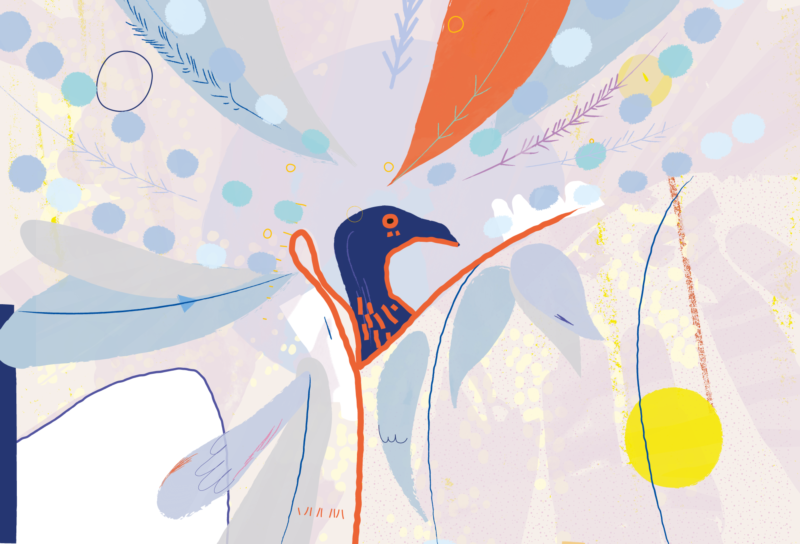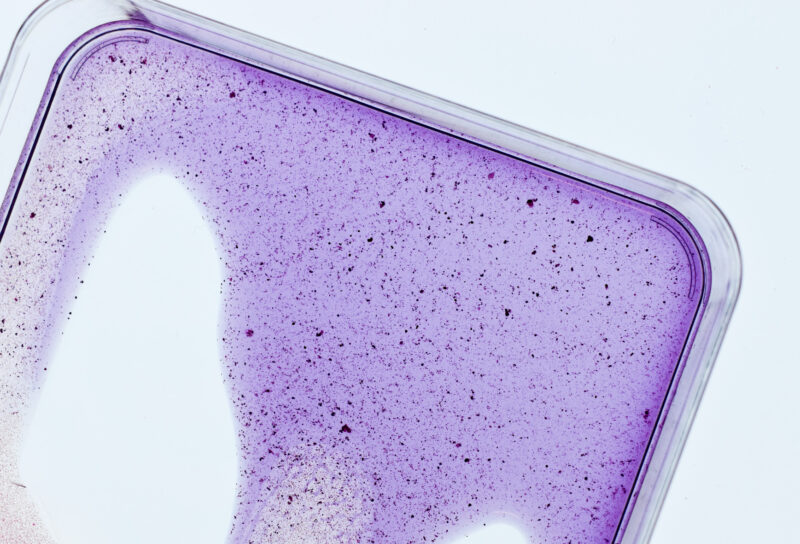At the very beginning, the newly formed Earth spun, coalesced, and cooled from a roiling boil to a gentle burble. Its surface temperatures fell to 100°C, liquid water started to settle, and then…what? This is the question that at some point preoccupies every biologist, chemist, theologist, or guy-really-thinking-about-things: how did we get life in there?
There was once a consensus answer to the question of how life began that seemed to please most people: God simply created everything. In the 18th century, philosophers like Lamarck offered an emotionally less satisfying explanation. Spontaneous generation, which became a form of anti-church rebelliousness, suggested that life simply leapt from nothingness. Louis Pasteur put an end to that in 1859 when he showed that a flask of broth open to the air immediately grew bacteria, while a flask with a long, swan-neck that kept the air out stayed sterile. An existential finding: life only arises from a previous generation of life. You can’t make something out of nothing.
That didn’t answer the question where this first burst of life came from, of course, and so people looked for extraterrestrial inspiration. “Cosmozoa,” microbes that rode meteorites and impregnated the Earth with life, became a fashionable idea for a while, despite a “formidable disregard for plausibility,” in the words of origin-of-life researcher Antonio Lazcano. And, really, the whole bacteria-flew-in-on-outer space-rocks thing doesn’t really answer the central question either. It just kicks the can down the road, to another planet.
This void was eventually filled by the RNA World hypothesis, which supplanted all other theories about 50 years ago. Ribonucleic acid (RNA), DNA’s molecular cousin, is a good candidate for the originator of all life. It can store genetic information and form double helices, which split, multiply, and pass down that information to a new generation of molecules. Like proteins, RNA can also catalyze the chemical reactions that power life. Information storage and catalysis are the great achievements of organic life, so an RNA can be thought of as life in molecular miniature. The idea goes that RNA could function as both book and author, simplifying the story of life’s origin to the formation of a single molecule. The RNA World hypothesis states that in the beginning, RNA formed, and from that one molecule, all life evolved.
The RNA World is still regarded as the field’s dominant theory, but it’s suffering. There is a rising tide of challenges to its fundamental viability, and emerging from them, a new, formidable opponent. Over the past twenty-five years, the Rodin-Ohno hypothesis has advanced an increasingly plausible counter-theory.
Unlike the RNA World, Rodin-Ohno doesn’t expect RNA to do all the work on its own. Instead of a lonely molecule swimming around the RNA World, it sees a molecular couple at the origin of life: a double-stranded RNA molecule hand-in-hand with a little pair of proteins. This is more than just an academic quibble. Rodin-Ohno is a marked departure from RNA World’s minimalistic singularity, and instead suggests a more messy and populated origin story. Beyond what it means for our understanding of creation, this clash of theories has fundamental implications for how we think about biology.
Neat vs. Messy
Like cosmozoa, the RNA World is a very neat and parsimonious idea. Like spontaneous generation, it lacks a detailed roadmap of how you’d get from point A (an all-RNA world) to point B (all life as we know it). Furthermore, RNA World leaves no space, no real reason even, for proteins to enter the equation. But proteins are life. They don’t store information, but they are the vehicle for all form and function in the natural world. If anything, an all-RNA system that is allowed to reproduce in peace may run away screaming from complex life — be it proteins, DNA, cells, or anything else.
In 1967, biochemist Sol Spiegelman repeatedly mixed viral RNA with replicases, proteins that copy RNA molecules. Spiegelman wondered: “What will happen to the RNA molecules if the only demand made on them is the Biblical injunction, multiply, with the biological proviso that they do so as rapidly as possible?” The viral RNA, known today as Spiegelman’s Monster, started to evolve. It changed to replicate faster over time. But it did so by losing information, jettisoning 83% of its sequence, essentially evolving in the opposite direction you’d expect a simple life-like molecule to go. The evolving-by-simplification existence of Spiegelman’s Monster suggests that a life cycle that only contains RNA is a closed loop. Adding complexity in the form of other molecules, like proteins, is impossible.
Struggling alone through the scorching, asteroid-pelted conditions of ancient Earth four billion years ago, lacking all support, strands of RNA would have likely fallen apart.
RNA World suffers from logical conundrums as well as biological and chemical ones. Forming long strands of RNA is disagreeably hard to achieve chemically in a primordial world. The linkages that hold the nucleotides in RNA together are hard to form without help from proteins that can stitch them together. “Did God make RNA?” asked the biochemist Christian de Duve, complaining in the late 1980s about this missing link. Struggling alone through the scorching, asteroid-pelted conditions of ancient Earth four billion years ago, lacking all support, strands of RNA would have likely fallen apart — if they had formed at all.
Other biologists note that the repertoire of chemical reactions that RNA can catalyze is quite limited, making it a counterintuitive starting point for all of life — particularly compared to proteins. Proteins consist of 20 amino acids with a variety of shapes and chemical characteristics. RNA uses four nucleotides that all look the same; and even that limited ability is extremely rare. To find potential RNA sequences that are capable of acting as catalysts, scientists have had to search through as many 1015 sequences. “[That] is an awful lot of RNA molecules,” conceded the biochemist Harold Bernhardt.
A Missing Link
The new alternative Origin of Life hypothesis envisions proteins wrapped around each other, like pieces of spaghetti stuck together, mirroring the double-stranded helix that RNA forms. Instead of an RNA molecule in an all-RNA World trying to carry life’s burdens all on its own — creating new RNA molecules, catalyzing chemical reactions — these two pairs split the work. Despite adding another level of dualism — RNA strands pair together to form a double helix, the proteins wound around each other, and the two pairs linked together — this idea radically simplifies the origin of life.
Any origin hypothesis has to account for both the origin of genetics — the storing and passing down of information from one generation to the next — and the origin of catalysis — the ability to speed up chemical reactions. The RNA World tries to saddle RNA with both roles while trying to shoehorn proteins in later. The Rodin-Ohno hypothesis says that if life today uses RNA (or DNA) for genetics, and proteins for catalysis, then both RNA and proteins must have been present at the origin of all life. Life today is a long, evolved expansion of what life has been from the very beginning.
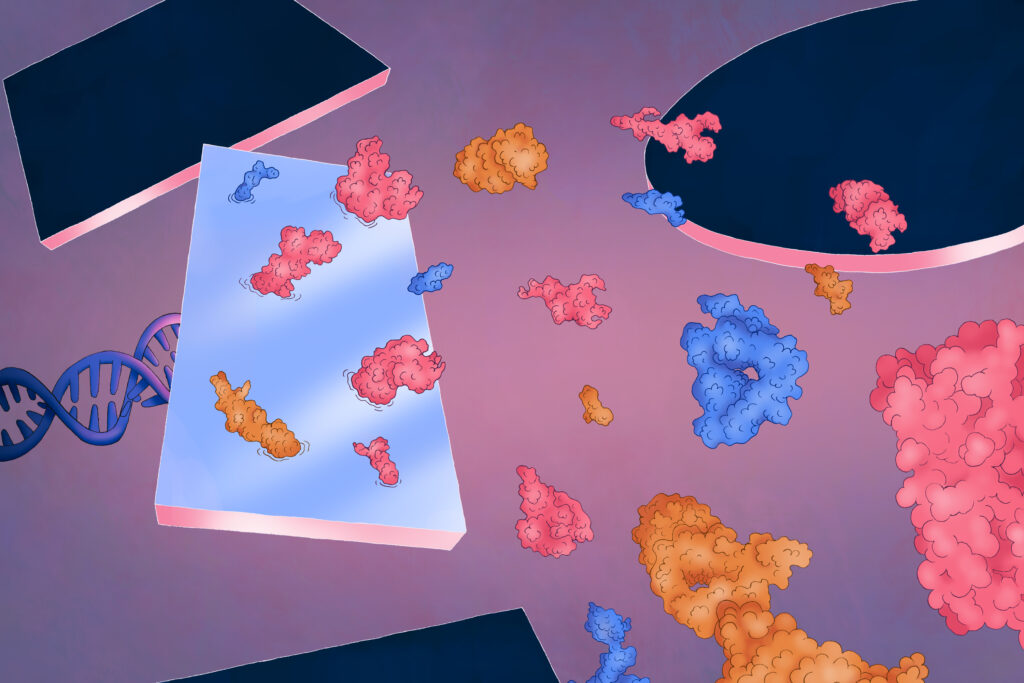
Unlike the RNA World, Rodin and Ohno’s hypothesis doesn’t need to explain how proteins and cells and all of molecular life’s other accouterments evolved. Instead, it suggests that life on Earth — the way that genomes create proteins, cells, and organisms — has always been a closed loop and can only be that way. Instead of asking “how did an all-RNA world create proteins?” Rodin-Ohno says they were simply both there from the jump.
In this world-building scenario, RNA acts as a rudimentary ribosome, the cellular megamachine that creates proteins. Instead of corralling and linking amino acids together, like a true ribosome does, the simple RNA in this world acts more like velcro that gently latches onto amino acids. They are brought closer to one another, progressively coalescing until the amino acids link into a protein chain. That protein then separates from the RNA’s velcro. Then, these proteins do the exact same thing for RNA: attracting and stabilizing nucleotides to form small RNA “genes.” It’s a molecular symbiosis: RNA building proteins, proteins building RNA. It is also the way life works today — genes create proteins, which make copies of genes. Two molecules, leaning on each other, surviving in the first few gasping moments of ancient existence.
Consider the Genetic Code
What exactly are these priomordial proteins? In all likelihood they are so-called aminoacyl tRNA-syntheases (aaRS) — the boatmen of biology, the proteins responsible for ferrying information from the genome to a phenotype. aaRS molecules determine which sequences in the genome are associated with which amino acid in a protein. They do this by assigning every amino acid a corresponding codon. Codons are the language of biology — sequences of three bases at a time that translate to one amino acid. aaRS are the arbiters of codons because they are responsible for ensuring that, when a ribosome is creating a protein, it has the correct amino acids available, the ones that correspond to the codons in the gene the ribosome is reading.
Every genome on Earth, virus, bacteria, plant, animal, uses this same code. Apart from their shared medium, genomes and proteins have nothing in common. Their only link is the genetic code, composed of codons. “A gene produces a protein phenotype that is unrelated to the gene itself without the intervention of the codons,” explains Charles Carter, a biochemist at the University of North Carolina, who has been working on origin-of-life theories with a series of collaborators, notably the physicist Peter Wills, for going on 50 years.
The aaRS proteins create codons. Accordingly, it is hard to imagine a scenario where aaRS could arise after genetic coding and codons were created. It’s a chicken-and-egg problem: how could a protein, which is created from the genetic instructions written in codons, also be the figure that controls which codons go to which amino acids? The answer offered by Carter, Ohno and Rodin is that aaRS were also there, in simplified form, from the very beginning.
aaRS molecules can be divided into two broad classes: Class I handles large amino acids, where class II handles small ones. In two landmark papers, published in 1995 and 2009, respectively, Ohno and Rodin demonstrated that the genes for class I and class II are mirror images of each other. They code for complementary sequences, one protein on each strand. On this bidirectionally coded molecule, the two proteins physically mirror each other. In the spots where class I aaRS have deep pockets that can hold large amino acids, class II aaRS have small pockets in the exact same place that can hold small amino acids. Small amino acids tend to live on the outside of proteins, where larger ones are buried on the inside. This means that even in the most minimal space possible, this model, two proteins, coded by two strands of RNA in a single double helix, can encode all of life.
Putting proteins front-and-center makes molecular life compellingly physical.
New substantiations arrived recently. In 2016, a group led by Carter, the University of North Carolina biochemist, showed that simplified aaRS proteins, the kind that can be coded by the same RNA molecule and may have existed at the beginning of all life, are functional, active, and by the standards of a pair of proteins, alive. In October 2021, a group of researchers in Tokyo replicated this work, a rare thing in origin-of-life research. eCarter feels buoyed by positive results coming from outside his lab, and is preparing grant applications to further this work. But something is missing. Life needs a system of transferring information from RNA to protein. In the Rodin-Ohno hypothesis, the aaRS proteins thought to exist are simplified, and do not yet control codons, the genetic code. The three letter genetic code evolved later. For two molecules to communicate with each other, they have to invent a code, any code.
New Models
“In 1974…I had the most exciting insight that I’ve ever had,” says Carter. He realized that information can only transfer from a gene to a protein if it has a medium through which to communicate. Something that repeats in some pattern. Modern biology has the codon table. But it’s unlikely that such a complex and sophisticated system existed in the early going. It does not matter what the code is; in the primordial world, the important thing is that a code is established at all. Once it’s established, the modern set of codons can evolve later.
Carter instead imagined a double stranded molecule of RNA and a simple two-strand protein molecule mirroring each other. Swimming in a sea of molecular building blocks, they could relax, unfurl, attract or repel those building blocks, creating new generations of molecules, building and evolving and then coming back together. He obsessed over this idea. “So I made a model,” he says.
He custom-built brass rods with “glands” on the end that accommodated metal coupling sleeves. In biology, molecules push and pull on each other, attracting and repelling until settling into an equilibrium. In his model, Carter pushes and pulls on the rods to create a model of proteins and RNA in a mirror relationship, each pushing and pulling on the other, mimicking those molecular attractions.
One day when tinkering with the model, the pieces suddenly snapped into place. At the perfect distance, where both molecules were in equilibrium, their molecular forces in perfect tension with each other, the RNA molecule and the protein molecule twisted together in synchrony — a primordial chemical rhythm. The protein and the RNA wove around each other in a predictable, repeating way. A bond formed between them at regular intervals, orienting each molecule in each chain towards a partner on the other side, again and again.
As the molecules wrap and mirror each other, Carter saw that for the length of every single nucleotide in RNA, the length of two, and only two amino acids twisted in perfect harmony with it. Not one and half amino acids, not two and a half; a perfect two-to-one. This, the idea goes, may have been the physical language that allows protein and RNA to build each other, as the Rodin-Ohno hypothesis and Carter suggest. One nucleotide corresponded to two amino acids. A simple language at the beginning of life.
Almost True
All this talk, papers flying back and forth describing hot chemicals exploding from vats zapped with synthetic lightning and strands and loops of RNA and proteins, elides the difference between two forms of life. There’s the origin story that resembles biology as we know it today, where genomes create transcripts which create proteins and a functioning genetic code and Central Dogma. And there’s the version that describes the first few hardscrabble molecules that stitched themselves together from nothingness.
These molecules predated the current genetic code, might not have been anything we’d recognize today, and were just doing their best to survive in those first few gasping moments. Louis Pasteur disproved the theory of spontaneous generation using a beaker with a long neck, but even modern biochemists had to note that there’s an end point, somewhere in the past. Life had to have come from nothingness at some point. Maybe that’s the beginning of a couple molecules, just barely hanging together. Or maybe it’s the beginning of some kind of coding and information transfer. It’s in the eye of the beholder.
Carter thinks that he, Rodin, and Ohno not only constructed a plausible scientific model, but they discovered the protein and gene that began all of life. Well, not necessarily. “This is not strictly true. It’s almost true,” says Carter. “And that’s one of the problems that bedevils this field is that almost everything I’m telling you is almost true.”
Take Rodin and Ohno’s discovery that aaRS genes complement each other: it’s not true for all parts of aaRS genes, it’s only true for the core parts of the protein, those thought to be the most ancient. Dividing large amino acids into class I and small ones into class II also only mostly holds. (Phenylalanine, for instance, is a huge class II amino acid.)
This is part of the problem with using genetics as an archaeological record: the record mutates and evolves over time. One paper discussing the RNA World, charmingly entitled “The RNA world hypothesis: the worst theory of the early evolution of life (except for all the other ones),” remarked: “In a sense then, one can say that the advent of coded protein synthesis has drawn a veil over the previous life of proteins.” Evolution, then, has eroded the traces of how life operated billions of years ago. The genome is filled with palimpsests. The traces are there, but they are smudged and overwritten.
Beyond its plausibility, I find Carter, Rodin, and Ohno’s theory the most comforting origin story. Putting proteins front-and-center in biology’s world makes molecular life compellingly physical. Proteins touch each other, they touch genes, they create and build the world of organic life. Viewing life through a genetic lens is pleasingly computational, as if things were being run by a well-organized, evolved machine that thinks linearly and human-like, if in a somewhat disorganized, error-prone way. I don’t want a biology like that. I am not given to abstractions, I want biology to do things, to be in contact with the physical world. It is not clean and computational, it is twisted and knotted, folded and misfolded. The roots of an ancient tree reach far underground, and it’s the proteins of the tree that set the expression, timing, and creation of the world.
